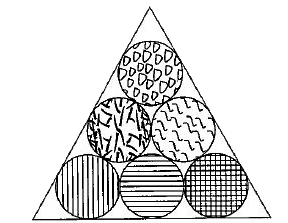The point on the x-axis which is equidistant from the points (7,6) and (-3, 4) is
(4,0)
(5,0)
(3,0)
(−6,0)
Step by step video solution for The point on the x-axis which is equidistant from the points (7,6) and (-3, 4) is by Maths experts to help you in doubts & scoring excellent marks in Class 10 exams.
Updated on:21/07/2023Topper's Solved these Questions
- SAMPLE PAPER 9 (SELF-ASSESSMENT)BOOK - EDUCART PUBLICATIONCHAPTER - SAMPLE PAPER 9 (SELF-ASSESSMENT)EXERCISE - Section-C (Case Study Based Questions)
10 Videos
- SAMPLE PAPER 9 (SELF-ASSESSMENT)BOOK - EDUCART PUBLICATIONCHAPTER - SAMPLE PAPER 9 (SELF-ASSESSMENT)EXERCISE - Section-C (Case Study Based Questions)
10 Videos
- SAMPLE PAPER 9BOOK - EDUCART PUBLICATIONCHAPTER - SAMPLE PAPER 9EXERCISE - SECTION C
10 Videos
- SAMPLE PAPER SELF ASSESSMENT 11BOOK - EDUCART PUBLICATIONCHAPTER - SAMPLE PAPER SELF ASSESSMENT 11EXERCISE - Section (iv)
13 Videos
Similar Questions
For teaching the concept of probability, Mrs. Verma decided to use two dice. Shet took a pair of die and write all the possible outcomes on the blackboard. All possible outcomes wave:

(1,1), (1,2), (1,3), (1,4), (1,5), (1,6)
(2,1), (2,2), (2,3), (2,4), (2,5), (2,6)
(3,1), (3,2), (3,3), (3,4), (3,5), (3,6)
(4,1), (4,2), (4,3), (4,4), (4,5), (4,6)
(5,1), (5,2), (5,3), (5,4), (5,5), (5,6)
(6,1), (6,2), (6,3), (6,4), (6,5), (6,6)
The probability that 4 will not come up on either of them is
View SolutionFor teaching the concept of probability, Mrs. Verma decided to use two dice. Shet took a pair of die and write all the possible outcomes on the blackboard. All possible outcomes wave:

(1,1), (1,2), (1,3), (1,4), (1,5), (1,6)
(2,1), (2,2), (2,3), (2,4), (2,5), (2,6)
(3,1), (3,2), (3,3), (3,4), (3,5), (3,6)
(4,1), (4,2), (4,3), (4,4), (4,5), (4,6)
(5,1), (5,2), (5,3), (5,4), (5,5), (5,6)
(6,1), (6,2), (6,3), (6,4), (6,5), (6,6)
The probability that 4 will not come up on either of them is
View SolutionCase Study-1:
Due to covid-19 lockdown, Ramesh decides to redo his house garden with some plantation work with his son. They have an equilateral triangle shaped garden and he has planted the garden with 6 different types of flowers (each of radius 1 m within a circular area). This left the remaining part of garden (that is outside the circular plants area) with lush green grass.

Now, comes the part of adding boundaries to corner the garden off nicely and he needs to know some calculations for it.
A boundary wall of height 25 cm is to be made around the garden leaving a space of 1 m wide for a gate on one side. The total length of boundary wall is
View SolutionProve that : cos2θ1−tanθ+sin3θsinθ−cosθ=1+sinθcosθ
View SolutionFind a point on the x-axis which is equidistant from the points (7, 6) and (−3, 4) .
View SolutionFind a point on the x-axis, which is equidistant from the point (7,6) and (3,4).
View SolutionFind a point on the x-axis, which is equidistant from the points (7,6) and (3, 4).
View SolutionFind a point on the x-axis, which is equidistant from the points (7,6) and (3, 4).
View SolutionFind a point on the x-axis, which is equidistant from the points (7,6) and (3, 4).
View SolutionFind a point on the x-axis, which is equidistant
from the points (7,6) and (3, 4).
View SolutionFind a point on the x-axis, which is equidistant from the points (7,6) and (3, 4).
View SolutionFind a point on the x-axis, which is equidistant from the points (7,6) and (3, 4).
View SolutionFind a point on the x-axis, which is equidistant from the point (7,6) and (3,4).
View SolutionFind a point on the X-axis, which is equidistant from the points (7,6)and(−3,4).
View SolutionFind the point on the x-axis, which is equidistant from (7,6) and (-3,4).
View SolutionFind a point on the x-axis,which is equidistant from the points (7,6) and (3,4)
View Solution
